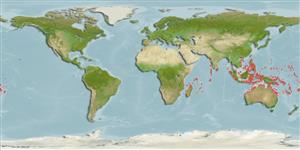Classification / Names
Common names from other countries
Référence principale
Taille / Poids / Âge
Max length : 45.0 cm SL mâle / non sexé; (Ref. 48637); âge max. reporté: 30 années (Ref. 52229)
Environnement
; marin récifal; profondeur 1 - 20 m (Ref. 90102)
Climat / Gamme
Tropical, preferred ?; 20°N - 25°S, 35°E - 172°W
Distribution
Western Indian Ocean: Mozambique (Ref. 41878). Indo-West Pacific: Seychelles (Ref. 10685), Philippines, Indonesia and Great Barrier Reef; recently found in Maldives. Reported from Malaysia (Ref. 5756) and Samoa (Ref. 592).
Pays | Zones FAO | Écosystèmes | Occurrences | Introductions
Description synthétique
Épines dorsales (Total): 9; Rayons mous dorsaux (Total): 25-26; Épines anales 3; Rayons mous anaux: 23 - 24. Color in life dark brown; orange brown from pectoral base downward; caudal spine socket bright orange; orange blotch before and behind pupil; caudal fin base with a white band. Anterior gill rakers 20-23, posterior 24-28. Large caudal spine, 2.2 - 4.4 in head.
Statut dans la liste rouge de l'IUCN (Ref. 115185)
Menace pour l'homme
Harmless
Utilisations par l'homme
Pêcheries: commercial
Plus d'informations
RéférencesAquacultureProfil d'aquacultureSouchesGénétiqueFréquences alléliquesHéritabilitéPathologiesTraitementMass conversion
CollaborateursImagesStamps, CoinsSonsCiguateraVitesseType de nageSurface branchialeOtolithesCerveauxVision
Outils
Articles particuliers
Télécharger en XML
Sources Internet
Estimates of some properties based on models
Phylogenetic diversity index
PD50 = 0.5000 many relatives (e.g. carps) 0.5 - 2.0 few relatives (e.g. lungfishes)
Niveau trophique
0
Résilience
Faible, temps minimum de doublement de population : 4,5 à 14 années (tmax=30; K=0.67)
Vulnérabilité
Low to moderate vulnerability (26 of 100)
Catégorie de prix
